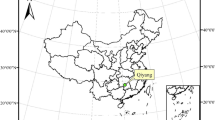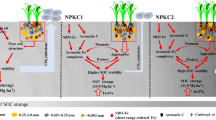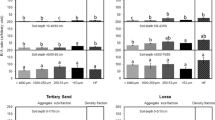Abstract
Purpose
Soil warming is predicted to increase the degradation of soil organic carbon. Aggregates of different sizes vary in their ability to retain or transfer iron oxide-bound organic carbon (Fe-bound OC) in soils. However, direct observation of iron oxides and OC distribution in soil aggregates and determination of their interactions in response to climate warming remain challenging.
Methods
To determine the response of soil aggregates to warming, a 180-day incubation experiment was conducted with Ultisol mixed with rice straw at different temperatures (4 °C, 25 °C, and 45 °C). Changes in concentrations of total organic carbon (TOC) and Fe-bound OC and distributions of OC species and Fe oxides were determined.
Results
Warming significantly increased the content of TOC in silt + clay and micro-aggregates but decreased it in macro-aggregates. Increasing temperatures decreased the contents of Fe-bound OC from 3.22 to 1.46 g kg−1 in silt + clay and from 5.20 to 1.83 g kg−1 in macro-aggregates. However, Fe-bound OC concentration decreased from 2.54 to 0.85 g kg−1 and then increased to 1.99 g kg−1 in micro-aggregates with increasing temperature. Nuclear magnetic resonance results suggested that increasing temperatures increased the proportions of aromatic C and carboxyl C in silt + clay and macro-aggregates but decreased those proportions in micro-aggregates. Synchrotron radiation-based Fourier-transform infrared spectroscopy indicated that warming promoted associations between Fe oxides and OC in silt + clay but decreased associations in macro-aggregates.
Conclusions
Our study indicates that soil warming increased the sensitivity of OC decomposition to a greater extent in micro-aggregates than in silt + clay and macro-aggregate fractions. Thus, although organo-Fe interactions are essential for OC stability, carbon forms associated with Fe oxide phases are not entirely resistant to degradation, especially for associations in different aggregate sizes. Determination of how warming affects Fe-bound OC distributions in size-dependent soil aggregates will improve understanding of the mechanisms that influence SOC stability and sequestration.
Graphical abstract





Similar content being viewed by others
Data availability statement
Data available on reasonable request from the corresponding author.
References
Adhikari D, Sowers T, Stuckey JW, Wang X, Sparks DL, Yang Y (2019) Formation and redox reactivity of ferrihydrite-organic carbon-calcium co-precipitates. Geochim Cosmochim Ac 244:86–98
Adhikari D, Yang Y (2015) Selective stabilization of aliphatic organic carbon by iron oxide. Sci Rep 5:11214
Angst G, Mueller KE, Nierop KG, Simpson MJ (2021a) Plant- or microbial-derived? A review on the molecular composition of stabilized soil organic matter. Soil Biol Biochem 156:108189
Angst G, Pokorný J, Mueller CW, Prater I, Preusser S, Kandeler E, Meador T, Straková P, Hájek T, van Buiten G, Angst Š (2021b) Soil texture affects the coupling of litter decomposition and soil organic matter formation. Soil Biol Biochem 159:108302
Bailey VL, Bond-Lamberty B, DeAngelis K, Grandy AS, Hawkes CV, Heckman K, Lajtha K, Phillips RP, Sulman BN, Todd-Brown KEO, Wallenstein MD (2018) Soil carbon cycling proxies: understanding their critical role in predicting climate change feedbacks. Global Change Biol 24:895–905
Bandyopadhyay PK (2020) Functional behaviour of soil physical parameters for regulating organic C pools. In Carbon management in tropical and sub-tropical terrestrial systems (pp. 233–247). Springer, Singapore
Bao Y, Bolan NS, Lai J, Wang Y, Jin X, Kirkham MB, Wu X, Fang Z, Zhang Y, Wang H (2021) Interactions between organic matter and Fe (hydr)oxides and their influences on immobilization and remobilization of metal(loid)s: a review. Crit Rev Env Sci Tec 1–22
Chen C, Dynes JJ, Wang J, Karunakaran C, Sparks DL (2014) Soft X-ray spectromicroscopy study of mineral-organic matter associations in pasture soil clay fractions. Environ Sci Technol 48:6678–6686
Chen S, Arrouays D, Angers DA, Chenu C, Barré P, Martin MP, Saby NPA, Walter C (2019) National estimation of soil organic carbon storage potential for arable soils: a data-driven approach coupled with carbon-landscape zones. Sci Total Environ 666:355–367
Dungait JA, Hopkins DW, Gregory AS, Whitmore AP (2012) Soil organic matter turnover is governed by accessibility not recalcitrance. Global Change Biol 18:1781–1796
Dynes JJ, Regier TZ, Snape I, Siciliano SD, Peak D (2015) Validating the scalability of soft X-ray spectromicroscopy for quantitative soil ecology and biogeochemistry research. Environ Sci Technol 49:1035–1042
Elliott TT (1986) Aggregate structure and carbon, nitrogen, and phosphorus in native and cultivated soils. Soil Sci Soc Am J 50:627–633
Georgiou K, Jackson RB, Vindušková O, Abramoff RZ, Ahlström A, Feng W, Harden JW, Pellegrini AFA, Wayne Polley H, Soong JL, Riley WJ, Torn MS (2022) Global stocks and capacity of mineral-associated soil organic carbon. Nat Commun 13:1–12
Grant KE, Galy VV, Haghipour N, Eglinton TI, Derry LA (2022) Persistence of old soil carbon under changing climate: the role of mineral-organic matter interactions. Chem Geol 587:120629
Han L, Sun K, Keiluweit M, Yang Y, Yang Y, Jin J, Sun H, Wu F, Xing B (2019) Mobilization of ferrihydrite-associated organic carbon during Fe reduction: adsorption versus coprecipitation. Chem Geol 503:61–68
Harris D, Horwáth WR, Van Kessel C (2001) Acid fumigation of soils to remove carbonates prior to total organic carbon or carbon-13 isotopic analysis. Soil Sci Soc Am J 65:1853–1856
Hernandez-Soriano MC, Dalal RC, Warren FJ, Wang P, Green K, Tobin MJ, Menzies NW, Kopittke PM (2018) Soil organic carbon stabilization: mapping carbon speciation from intact microaggregates. Environ Sci Technol 52:12275–12284
Huang X, Tang H, Kang W, Yu G, Ran W, Hong J, Shen Q (2018) Redox interface-associated organo-mineral interactions: a mechanism for C sequestration under a rice-wheat cropping system. Soil Biol Biochem 120:12–23
Jasinska E, Wetzel H, Baumgartl T, Horn R (2006) Heterogeneity of physico-chemical properties in structured soils and its consequences. Pedosphere 16:284–296
Jeewani PH, Luo Y, Yu G, Fu Y, He X, Van Zwieten L, Liang C, Kumar A, He Y, Kuzyakov Y, Qin H, Guggenberger G, Xu J (2021) Arbuscular mycorrhizal fungi and goethite promote carbon sequestration via hyphal-aggregate mineral interactions. Soil Biol Biochem 162:108417
Jia J, Cao Z, Liu C, Zhang Z, Lin L, Wang Y, Haghipour N, Wacker L, Bao H, Dittmar T, Simpson MJ, Yang H, Crowther TW, Eglinton TI, He J, Feng X (2019) Climate warming alters subsoil but not topsoil carbon dynamics in alpine grassland. Global Change Biol 25:4383–4393
Kirsten M, Mikutta R, Vogel C, Thompson A, Mueller CW, Kimaro DN, Bergsma HLT, Feger K, Kalbitz K (2021) Iron oxides and aluminous clays selectively control soil carbon storage and stability in the humid tropics. Sci Rep 11:1–12
Kleber M, Bourg IC, Coward EK, Hansel CM, Myneni SC, Nunan N (2021) Dynamic interactions at the mineral–organic matter interface. Nat Rev Earth Environ 2:402–421
Kramer MG, Chadwick OA (2018) Climate-driven thresholds in reactive mineral retention of soil carbon at the global scale. Nat Clim Change 8:1104–1108
Lalonde K, Mucci A, Ouellet A, Gélinas Y (2012) Preservation of organic matter in sediments promoted by iron. Nature 483:198
Lehmann J, Kinyangi J, Solomon D (2007) Organic matter stabilization in soil microaggregates: implications from spatial heterogeneity of organic carbon contents and carbon forms. Biogeochemistry 85:45–57
Lehmann J, Solomon D, Kinyangi J, Dathe L, Wirick S, Jacobsen C (2008) Spatial complexity of soil organic matter forms at nanometre scales. Nat Geosci 1:238
Li H, Hu Z, Wan Q, Mu B, Li G, Yang Y (2022a) Integrated application of inorganic and organic fertilizer enhances soil organo-mineral associations and nutrients in tea garden soil. Agronomy 12:1330
Li Q, Hu W, Li L, Li Y (2022b) Interactions between organic matter and Fe oxides at soil micro-interfaces: quantification, associations, and influencing factors. Sci the Total Environ 855:158710
Li Q, Wang Y, Li Y, Li L, Tang M, Hu W, Chen L, Ai S (2022c) Speciation of heavy metals in soils and their immobilization at micro-scale interfaces among diverse soil components. Sci Total Environ 825:153862
Liang A, Zhang Y, Zhang X, Yang X, McLaughlin N, Chen X, Guo Y, Jia S, Zhang S, Wang L, Tang J (2019) Investigations of relationships among aggregate pore structure, microbial biomass, and soil organic carbon in a Mollisol using combined non-destructive measurements and phospholipid fatty acid analysis. Soil till Res 185:94–101
Liu XJA, Pold G, Domeignoz-Horta LA, Geyer KM, Caris H, Nicolson H, Kemner KM, Frey SD, Melillo JM, DeAngelis KM (2021) Soil aggregate-mediated microbial responses to long-term warming. Soil Biol Biochem 152:108055
Lu RK (1999) Analytical methods of soil and agricultural chemistry (in Chinese). China Agricultural Science and Technology Press, Beijing
Lugato E, Lavallee JM, Haddix ML, Panagos P, Cotrufo MF (2021) Different climate sensitivity of particulate and mineral-associated soil organic matter. Nat Geosci 14:295–300
Melillo JM, Frey SD, Deangelis KM, Werner WJ, Bernard MJ, Bowles FP, Pold G, Knorr MA, Grandy AS (2017) Long-term pattern and magnitude of soil carbon feedback to the climate system in a warming world. Science 358:101–105
Miller LM, Dumas P (2006) Chemical imaging of biological tissue with synchrotron infrared light. BBA-Biomembranes 1758:846–857
Minasny D, Malone BP, McBratney AB, Angers DA, Arrouays D, Chambers A, Chaplot V, Chen ZS, Cheng K, Das BS, Field DJ, Gimona A, Hedley CB, Hong SY, Mandal B, Marchant BP, Martin M, McConkey BG, Mulder VL, O’Rourke S, Richer-de-Forges AC, Odeh I, Padarian J, Paustian K, Pan G, Poggio L, Savin I, Stolbovoy V, Stockman U, Sulaeman Y, Sulaeman CC, Vagen TG, van Wesemael B, Winowiecki L (2017) Soil carbon 4 per mille. Geoderma 292:59–86
Mu CC, Zhang TJ, Zhao Q, Guo H, Zhong W, Su H, Wu QB (2016) Soil organic carbon stabilization by iron in permafrost regions of the Qinghai-Tibet Plateau. Geophys Res Lett 43:10–286
Patzner MS, Mueller CW, Malusova M, Baur M, Nikeleit V, Scholten T, Hoeschen C, Byrne JM, Borch T, Kappler A, Bryce C (2020) Iron mineral dissolution releases iron and associated organic carbon during permafrost thaw. Nat Commun 11:1–11
Pronk GJ, Heister K, Ding GC, Smalla K, Kögel-Knabner I (2012) Development of biogeochemical interfaces in an artificial soil incubation experiment; aggregation and formation of organo-mineral associations. Geoderma 189:585–594
Rabot E, Wiesmeier M, Schlüter S, Vogel HJ (2018) Soil structure as an indicator of soil functions: a review. Geoderma 314:122–137
Rumpel C, Eusterhues K, Kögel-Knabner I (2010) Non-cellulosic neutral sugar contribution to mineral associated organic matter in top-and subsoil horizons of two acid forest soils. Soil Biol Biochem 42:379–382
Sarker JR, Singh BP, Cowie AL, Fang Y, Collins D, Dougherty WJ, Singh BK (2018a) Carbon and nutrient mineralisation dynamics in aggregate-size classes from different tillage systems after input of canola and wheat residues. Soil Biol Biochem 116:22–38
Sarker TC, Incerti G, Spaccini R, Piccolo A, Mazzoleni S, Bonanomi G (2018b) Linking organic matter chemistry with soil aggregate stability: Insight from 13C NMR spectroscopy. Soil Biol Biochem 117:175–184
Schlüter S, Leuther F, Albrecht L, Hoeschen C, Kilian R, Surey R, Mikutta R, Kaiser K, Mueller CW, Vogel HJ (2022) Microscale carbon distribution around pores and particulate organic matter varies with soil moisture regime. Nat Commun 13:1–14
Schmidt MW, Torn MS, Abiven S, Dittmar T, Guggenberger G, Janssens IA, Kleber M, Kögel-Knabner I, Lehmann J, Manning DAC, Nannipieri P, Rasse DP, Weiner S, Trumbore SE (2011) Persistence of soil organic matter as an ecosystem property. Nature 478:49–56
Schmidt MWI, Knicker H, Hatcher PG, Kögel-Knabner I (1997) Improvement of 13C and 15N CPMAS NMR spectra of bulk soils, particle size fractions and organic material by treatment with 10% hydrofluoric acid. Eur J Soil Sci 48:319–328
Schnecker J, Borken W, Schindlbacher A, Wanek W (2016) Little effects on soil organic matter chemistry of density fractions after seven years of forest soil warming. Soil Biol Biochem 103:300–307
Schöning I, Knicker H, Kögel-Knabner I (2005) Intimate association between O/N-alkyl carbon and iron oxides in clay fractions of forest soils. Org Geochem 36:1378–1390
Shi H, Wen D, Huang Y, Xu S, Deng T, Li F, Wu Z, Wang X, Zhao P, Wang F, Du R (2022) Time effects of rice straw and engineered bacteria on reduction of exogenous Cu mobility in three typical Chinese soils. Pedosphere 32:665–672
Six J, Paustian K (2014) Aggregate-associated soil organic matter as an ecosystem property and a measurement tool. Soil Biol Biochem 68:A4–A9
Soil Survey Staff (2014) Keys to Soil Taxonomy, 12th, ed., U.S. Department of Agriculture. Natural Resources Conservation Service
Song X, Wang P, Van Zwieten L, Bolan N, Wang H, Li X, Cheng K, Yang Y, Wang M, Liu T, Li F (2022) Towards a better understanding of the role of Fe cycling in soil for carbon stabilization and degradation. Carbon Res 1:1–16
Spielvogel S, Prietzel J, Kögel-Knabner I (2008) Soil organic matter stabilization in acidic forest soils is preferential and soil type-specific. Eur J Soil Sci 59:674–692
Steffens M, Rogge DM, Mueller CW, Höschen C, Lugmeier J, Kölbl A, Kögel-Knabner I (2017) Identification of distinct functional microstructural domains controlling C storage in soil. Environ Sci Technol 51:12182–12189
Sun F, Yu GH, Polizzotto ML, Ran W, Shen Q (2019) Toward understanding the binding of Zn in soils by two-dimensional correlation spectroscopy and synchrotron-radiation-based spectromicroscopies. Geoderma 337:238–245
Tian J, Pausch J, Yu G, Blagodatskaya E, Gao Y, Kuzyakov Y (2015) Aggregate size and their disruption affect 14C-labeled glucose mineralization and priming effect. Appl Soil Ecol 90:1–10
Tian S, Zhu B, Yin R, Wang M, Jiang Y, Zhang C, Li D, Chen X, Kardol P, Liu M (2022) Organic fertilization promotes crop productivity through changes in soil aggregation. Soil Biol Biochem 165:108533
Totsche KU, Amelung W, Gerzabek MH, Guggenberger G, Klumpp E, Knief C, Lehndorff E, Mikutta R, Peth S, Prechtel A, Ray N, Kögel-Knabner I (2018) Microaggregates in soils. J Plant Nutr Soil Sc 181:104–136
Wan D, Ye T, Lu Y, Chen W, Cai P, Huang Q (2019) Iron oxides selectively stabilize plant-derived polysaccharides and aliphatic compounds in agricultural soils. Eur J Soil Sci 70:1153–1163
Wang Y, Gao S, Li C, Zhang J, Wang L (2016) Effects of temperature on soil organic carbon fractions contents, aggregate stability and structural characteristics of humic substances in a Mollisol. J Soil Sediment 16:1849–1857
Wang Y, Wang H, He JS, Feng X (2017) Iron-mediated soil carbon response to water-table decline in an alpine wetland. Nat Commun 8:15972
Warren J, Ziegler SE (2017) A solid phase extraction method for isolating HF-extractable soil organic matter for NMR analysis. Org Geochem 111:1–8
Wiesmeier M, Urbanski L, Hobley E, Lang B, von Lützow M, Marin-Spiotta E, van Wesemael B, Rabot E, Ließ M, Garcia-Franco N, Wollschläger U, Vogel H, Kögel-Knabner I (2019) Soil organic carbon storage as a key function of soils-a review of drivers and indicators at various scales. Geoderma 333:149–162
Wu L, Zhang Y, Guo X, Ning D, Zhou X, Feng J, Yuan MM, Liu S, Guo J, Gao Z, Ma J, Kuang J, Jian S, Han S, Yang Z, Ouyang Y, Fu Y, Xiao N, Liu X, Wu L, Zhou A, Yang Y, Tiedje JM, Zhou J (2022) Reduction of microbial diversity in grassland soil is driven by long-term climate warming. Nat Microbiol 7:1054–1062
Xu Y, Liu K, Yao S, Zhang Y, Zhang X, He H, Feng W, Ndzana GM, Chenu C, Olk DC, Mao J, Zhang B (2022) Formation efficiency of soil organic matter from plant litter is governed by clay mineral type more than plant litter quality. Geoderma 412:115727
Yeasmin S, Singh B, Johnston CT, Sparks DL (2017) Organic carbon characteristics in density fractions of soils with contrasting mineralogies. Geochim Cosmochim Ac 218:215–236
Yeasmin S, Singh B, Smernik RJ, Johnston CT (2020) Effect of land use on organic matter composition in density fractions of contrasting soils: a comparative study using 13C NMR and DRIFT spectroscopy. Sci Total Environ 726:138395
Yu H, Ding W, Chen Z, Zhang H, Luo J, Bolan N (2015) Accumulation of organic C components in soil and aggregates. Sci Rep 5:13804
Zhang X, Xin Y, Zhang Z, Xue Z, Wu H (2022) Soil moisture and aromatic-containing compounds control soil organic carbon associated with iron oxides in permafrost wetland soils along the Yarlung Tsangbo River, Tibet. J Soil Sci Plant Nut 1–11
Zhong XL, Li JT, Li XJ, Ye YC, Liu SS, Hallett PD, Ogden MR, Naveed M (2017) Physical protection by soil aggregates stabilizes soil organic carbon under simulated N deposition in a subtropical forest of China. Geoderma 285:323–332
Acknowledgements
This work was financially supported by the National Natural Science Foundation of China (42107037), the Guangdong Basic and Applied Basic Research Foundation (2022A1515011797), the Innovation Foundation of Guangdong Academy of Agricultural Sciences (212114), the Guangzhou Basic and Applied Basic Research Foundation (202102020311), and the Modern Agricultural Industrial Technology System of Guangdong Province (The Task of Innovation Team Building of Key Generic Technologies in Agricultural Resources and Environment) (2022KJ118). Sincere thanks are given to the staff at beamline BL01B of the National Synchrotron Radiation Laboratory (NSRL, Hefei, China). We thank LetPub (www.letpub.com) for linguistic assistance and presubmission expert review.
Author information
Authors and Affiliations
Corresponding author
Ethics declarations
Consent for publication
All authors have read and approved the paper, and it has not been published previously nor is it being considered by any other peer-reviewed journal.
Conflict of interest
The authors declare no competing interests.
Additional information
Responsible editor: Claudio Colombo
Publisher's Note
Springer Nature remains neutral with regard to jurisdictional claims in published maps and institutional affiliations.
Rights and permissions
Springer Nature or its licensor (e.g. a society or other partner) holds exclusive rights to this article under a publishing agreement with the author(s) or other rightsholder(s); author self-archiving of the accepted manuscript version of this article is solely governed by the terms of such publishing agreement and applicable law.
About this article
Cite this article
Li, Q., Guo, G., Singh, B.P. et al. Associations of soil Fe oxides and organic carbon vary in different aggregate fractions under warming. J Soils Sediments 23, 2744–2755 (2023). https://doi.org/10.1007/s11368-023-03532-9
Received:
Accepted:
Published:
Issue Date:
DOI: https://doi.org/10.1007/s11368-023-03532-9




